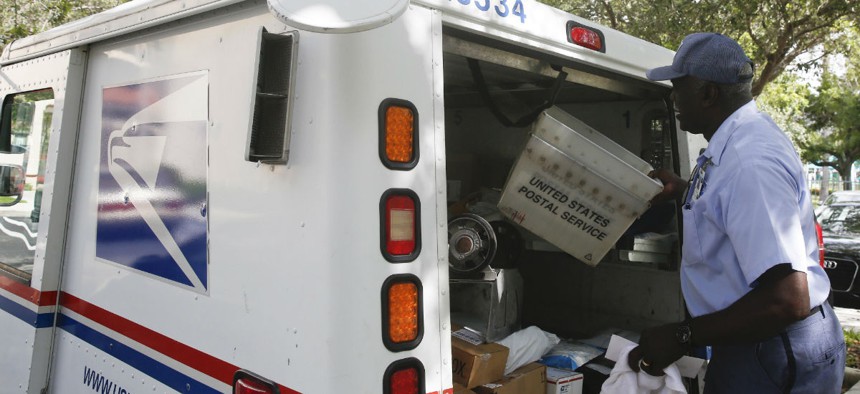
Brynn Anderson / AP
USPS Cuts 10K Positions After Five Years of Job Growth
Reductions come as Postal Service pays down its debts for first time in eight years.
The U.S. Postal Service shed 10,000 jobs in fiscal 2018, the first time in five years the mailing agency posted a net reduction in jobs.
USPS employed 634,000 people last fiscal year, according to a financial analysis released by the Postal Regulatory Commission on Monday, its lowest total since fiscal 2015. While the cash-strapped agency has trended toward a smaller workforce over the last two decades—it has slashed 300,000 career workers since 1999—its total number of employees has inched up each year since fiscal 2013.
The Postal Service has in recent years increasingly relied on non-career workers, such as postal support employees and mailhandler assistants, as a cheaper alternative to reduce labor costs as part of efforts to keep pace with shrinking mail revenue. The agency's non-career staff had grown each year since fiscal 2010, increasing more than 60% by fiscal 2017. Even that cadre of employees shrunk last year, however, dropping by 4,000 employees.
USPS lost a net of $3.9 billion in fiscal 2018, despite seeing revenues increase by $1 billion. That included expenses outside of management’s control, such as funding for future retiree health benefits, as well as “controllable losses” from growing operational costs. Fiscal 2017 marked the first time in five years that the Postal Service failed to turn a profit on controllable operations.
Dave Partenheimer, a USPS spokesman, said the workforce cuts last year were necessary to fit with the agency’s new reality.
“Simply put, our workforce decreased to align with changes in mail volume,” Partenheimer said. He declined to predict whether there will be additional losses for the current fiscal year.
In an unusual move for the Postal Service in recent years, it made $1.8 billion in repayments on its $15 billion debt to the U.S. Treasury in fiscal 2018. It marked the first time since fiscal 2011 the Postal Service made such payments. PRC, the USPS regulator, said the mailing agency’s liquidity improved because it has not made payments toward its Retiree Health Benefits Fund since fiscal 2010. It has also declined to make required payments toward its unfunded pension liabilities.
USPS’ current liabilities total $89.3 billion, PRC said, dwarfing its $26.7 billion in assets.
While normal, first-class mail revenue continues to drop precipitously, overall revenues have grown as shipping and package income has surged. That has led, however, to a corresponding increase in transportation and labor costs. While the workforce shrunk year-over-year in fiscal 2018, total personnel costs grew by $1.7 billion. PRC also cautioned that the rate of growth in that sector is starting to decline.
Postal management is expecting some relief in 2019. The PRC approved new postal rates this year, allowing USPS to increase the cost of a stamp by 5 cents and raise the cost of its offerings across the board by an average of 2.5%. Those changes, according to Chief Financial Officer Joe Corbett, would have added nearly $1.7 billion in revenue if they were in place during fiscal 2018.
President Trump has proposed a $98 billion savings package through a slew of legislative reforms. In addition to a renewed push for offering postal employees lower pay and benefits, Trump has pushed changes recommended by the task force he created last year. Those include raising prices for mail and packages not deemed “essential,” reducing delivery frequency, outsourcing some mail processing and licensing access to individuals’ mailboxes.







